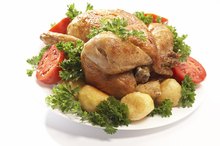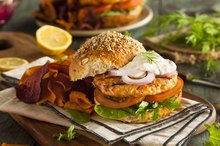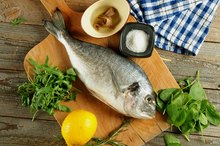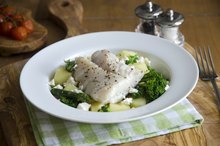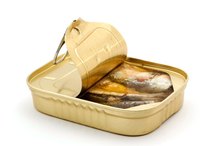What does fact checked mean?
At Healthfully, we strive to deliver objective content that is accurate and up-to-date. Our team periodically reviews articles in order to ensure content quality. The sources cited below consist of evidence from peer-reviewed journals, prominent medical organizations, academic associations, and government data.
The information contained on this site is for informational purposes only, and should not be used as a substitute for the advice of a professional health care provider. Please check with the appropriate physician regarding health questions and concerns. Although we strive to deliver accurate and up-to-date information, no guarantee to that effect is made.
Diabetes is a disease that affects your body's ability to properly use and store sugars from the foods you eat. Your body either does not make or does not respond to insulin, which is the chemical that causes glucose to be removed from your blood after a meal. While most diabetics can enjoy all foods in moderation, your diet should consist mainly of healthy foods full of vitamins and minerals. Fish is an excellent food for diabetics because it provides many of the nutrients found in meat without unnecessary saturated fat and calories. The American Heart Association indicates that you should have two 3.5-ounce servings of fish per week for the greatest health benefits 12.
Salmon
Salmon is a fatty fish full of protein and omega-3 fatty acids, but low in saturated fat 1. According to the American Diabetes Association, diabetics are at increased risk for developing heart disease, and omega-3 fats are important for your cardiovascular health 12. The American Heart Association indicates that omega-3s decrease triglyceride levels, lower blood pressure, slow the rate of plaques forming in your arteries and decrease the risk of developing an abnormal heart rhythm 12. Salmon provides you with lean protein that will lead to weight loss, and protein has been shown to help regulate your blood sugar. Salmon is also low in mercury, and you can safely consume up to twelve ounces per week. It is available in wild and farmed varieties. Prepare your salmon meals by baking, grilling or broiling. Avoid frying salmon to keep from taking in unnecessary saturated fat.
- Salmon is a fatty fish full of protein and omega-3 fatty acids, but low in saturated fat 1.
- Salmon is also low in mercury, and you can safely consume up to twelve ounces per week.
Sardines
Fish & Chicken Diet
Learn More
Sardines are also a good source of omega-3 fats, and they are low in saturated fat. They contain as much calcium as a glass of milk, the B vitamin niacin, protein and iron. They are a convenient fish choice, since you can buy them fresh or canned and packed in oil. Sardines are also low in mercury. Grill fresh sardines, or add canned sardines to sandwiches or salads. Three whole fresh sardines have about 280 calories, while one 3.75 ounce can of sardines contains 191 calories.
- Sardines are also a good source of omega-3 fats, and they are low in saturated fat.
Cod
Cod is a low-fat fish with no carbohydrates. A serving of one fillet has only 1.5 g of fat with 189 calories. Atlantic cod is a good source of omega-3 fatty acids, but it also contains a small amount of omega-6 fats as well. A serving of cod will provide you with small amounts of vitamin A, vitamin C, calcium and iron. Cod is also a good source of B vitamins, with 32 percent of your daily value of vitamin B12 and 25 percent of your vitamin B6. Cod contains low levels of mercury, and it is one of the most commonly eaten fish.
- Cod is a low-fat fish with no carbohydrates.
- Cod is also a good source of B vitamins, with 32 percent of your daily value of vitamin B12 and 25 percent of your vitamin B6.
Mackerel
Nutrition of Salmon Burgers
Learn More
Pacific mackerel is a fatty fish that contains about 3.2 grams of omega-3 fatty acids per six-ounce serving 1. One cup of Pacific mackerel contains 296 calories, and it is also a good source of protein, iron, riboflavin, vitamin B12, selenium and niacin. This fish is occasionally available fresh, but it is most often canned and sold in grocery stores. Atlantic mackerel is available fresh, and it is low in mercury. However, avoid king mackerel since it is a high-mercury fish.
- Pacific mackerel is a fatty fish that contains about 3.2 grams of omega-3 fatty acids per six-ounce serving 1.
- One cup of Pacific mackerel contains 296 calories, and it is also a good source of protein, iron, riboflavin, vitamin B12, selenium and niacin.
Related Articles
References
- American Heart Association: Fish and Omega-3 Fatty Acids
- American Diabetes Association: Lean Meats
- Omega-3 Fatty Acids. (2016). Retrieved January 18, 2018, from http://ods.od.nih.gov/factsheets/Omega3FattyAcidsandHealth-HealthProfessional/
- Jouris, K. B., McDaniel, J. L., & Weiss, E. P. (2011). The effect of omega-3 fatty acid supplementation on the inflammatory response to eccentric strength exercise. Journal of Sports Science & Medicine, 10(3), 432.
- Tartibian, B., Maleki, B. H., & Abbasi, A. (2009). The effects of ingestion of omega-3 fatty acids on perceived pain and external symptoms of delayed onset muscle soreness in untrained men. Clinical Journal of Sport Medicine, 19(2), 115-119.
- Parra, D., Ramel, A., Bandarra, N., Kiely, M., MartÃnez, J. A., & Thorsdottir, I. (2008). A diet rich in long chain omega-3 fatty acids modulates satiety in overweight and obese volunteers during weight loss. Appetite, 51(3), 676-680.
- Omega-3 Fatty Acids. (2016). Retrieved January 18, 2018, from
- Daley, C. A., Abbott, A., Doyle, P. S., Nader, G. A., & Larson, S. (2010). A review of fatty acid profiles and antioxidant content in grass-fed and grain-fed beef. Nutrition Journal, 9(1), 10.
- Covington, M. B. (2004). Omega-3 fatty acids. Atlantic, 1(2.0)
Writer Bio
Based in Virginia, Tyffani Benard began writing health-related articles in 2010. Her work has appeared in various online publications. Benard has a background in dentistry and science, and enjoys making these complicated subjects accessible to the general public through her writing. She holds a Doctor of Dental Surgery from Howard University and a Bachelor of Science in biology from Florida A&M University.
